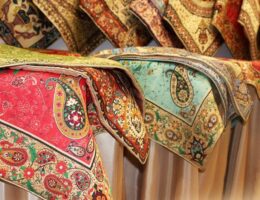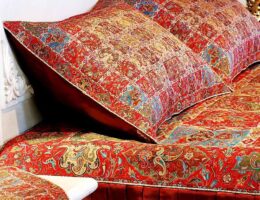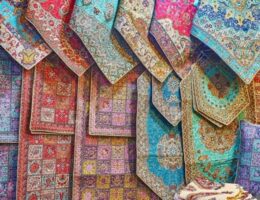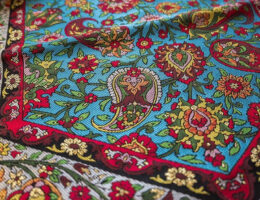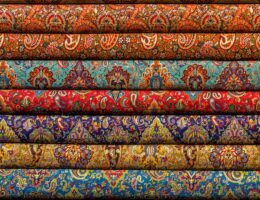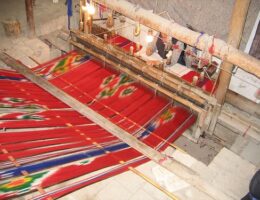IRAN ART EXHIBITION: TERMEH A PERSIAN HANDWOVEN CLOTH
For more than 400 years, Termeh has been the most sumptuous Iranian handwoven cloth. This luxurious fabric was woven by natural silk and wool fiber. It was traded throughout the Aryan trade regions, where now we know as the Silk Roads.
Yazd has the reputation of producing high-quality Termeh products such as scarves, cushion covers, and mats. They are used to produce curtains, garments, quilt covers, cummerbunds (Persian kammar-band meaning waistbands), robes and even royal headdresses such as turbans.
Nowadays, the more expensive Termehs are usually used as floor spreadsheets and tablecloths; which are about 150 cm2 [five-feet square]. It takes the form of sheets, panels, and other shapes.
Persian Termeh is found in a diverse range of background colors like jujube red, light red, green, orange and black. Different criteria affect the price of a piece of splendid Termeh.
For instance, the number of colors used is a very important factor representing how much labor was used for only 25 to 30 centimeters of each Termeh. As the number of colors increases the piece is priced dramatically higher. Pieces with lining are priced higher than pieces without lining, too. The third factor is the trim. As the trim used becomes wider and more expensive the piece is priced higher.
Naghsh-e Jahan square, with more than 20 shops, provides you with numerous opulent Termeh products. But if you are looking for Rezaei, Hashemi and Hosseini Termeh as the oldest producers of this luxurious Persian souvenir, you can enjoy visiting the workshop and stories in Yazd and Kerman.
Words are not enough to show you the heavenly beauty of Iran’s ancient handicraft, so you are invited to enjoy watching Iran’s most luxurious handwoven cloth:
IRAN ART EXHIBITION: Hand woven Termeh, production of which became trendy in Iran in the beginning of Safavid era, is a soft and elegant cloth which is made of different threads material such as silk wool and fluff. It is often decorated with original and traditional Iranian patterns especially the paisley pattern. They are hand weaved by the use of a 4-way foundation. The weft threads of Termeh cloth are very dense and they are left freely on the back of the Termeh cloth. Although some believe that Terhmeh originated from the central Asia and heights of Kashmir, others believe that Termeh weaving originates from Iran and then it found its way to Kashmir. One thing that can be said about this very elegant cloth is that the artistic taste, style and Iranian’s innovation in the material and the visionary patterns used for weaving this soft cloth is rare and unique throughout the world.
This art reached its peak of development and evolution during the Safavid era and which became world famous and one of the exporting goods of Iran. Since old times, Termeh was used for many different purposes such as: sewing costly and royal clothing, curtains, robe, prayer rug. Nowadays, Termeh is used for table cloths, sofa fabric, pillow covers. In the past, the people who bought Termeh products were mostly riches, kings and royalty and in the present, mostly people of the upper class and middle class of the society buy Termeh products as gifts for weddings, Eids and formal or family ceremonies.
The first step in weaving Termeh is gathering the raw matterials, which gathering the fabrics, wool, fluff or silk, Washing, dyeing spinning of them, is of great importance. After that, Chelle Keshi is done the same as other traditional hand woven textiles and looming products and the weaving starts afterwards which is a precise, sensitive and time consuming procedure. The weft string in Termeh clothes is very dense and is placed free behind the cloth. The Termeh looming machine is wooden and very much alike other looming machines. This type of machine has Chaharvardi and these Vardies move via the pedals that are placed under the weaver’s feet. The color combinations in Termeh is quite eye catching. So much so that usually in the choosing process of the pattern and designs matching colors are chosen. The colors mostly used in Termeh are sangria red, light red, green, orange and black.
Termeh Industry was very prosperous because of its popularity and different usages by the upper class of society until factory made clothes and textiles were imported into the markets. Its prosperity in past was so that in cities like Yazd, Kerman and Isfahan, there were many Termeh Workshops and those cities were the most important centers for Termeh weaving production. But in present this industry is nearly abolished.
IRAN ART EXHIBITION: Yazd is the center of the design, producing and marketing of Termeh.Weaving termeh requires a good wool with long fibers. Termeh is woven by an expert with the assistance of a worker called a Goushvareh-kesh. Weaving termeh is a sensitive, careful, and time-consuming process; a good weaver can produce only 25 to 30 centimetres (10 to 12 in) in a day. The background colors used in termeh are jujube red, light red, green, orange and black. Termeh has been admired throughout history; Greek historians commented on the beauty of Persian weavings in the Achaemenian (532 B.C.), Ashkani (222 B.C.) and Sasanidae (226–641 A.D.) periods and the Chinese tourist Hoang Tesang admired termeh.
During the Safavid period (1502–1736 A.D.), zarbaf and termeh weaving techniques were significantly refined. Due to the difficulty of producing termeh and the advent of mechanized weaving, few factories remain in Iran that produce traditionally woven Termeh.
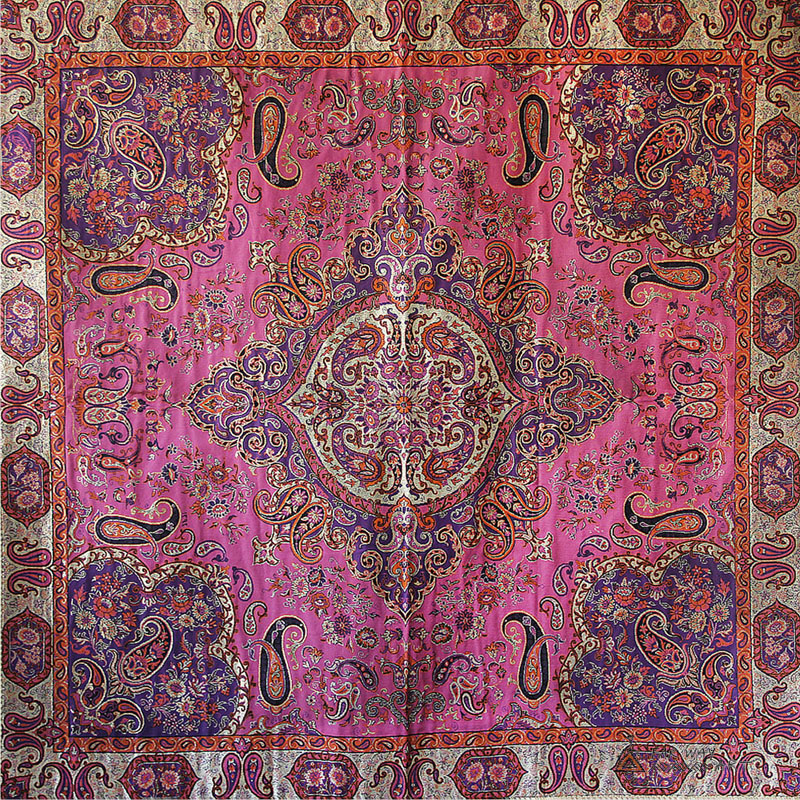
Cashmere weaving steps:
A) Raw materials used: The first step of cashmere weaving is to prepare its raw materials. Cashmere is usually woven from wool and silk, but white wool is the most common wool used in cashmere weaving because it can be any color you want. Dyed cashmere wool should be high quality and have long fibers that Iranian and Kashmir sheep have good soft and strong wool and is largely shiny and white and the best fleece in the area of the sides – abdomen – back of the neck and head and legs There is and usually these wools are used for cashmere weaving. How to prepare – spin and dye and weave wool in the 16th century AD in Iran was very advanced. The period of Shah Abbas Safavid can be considered as the peak and flourishing period of cashmere weaving industry, because Shah Abbas invited prominent designers from China and Armenia to Iran to teach their new art to Iranians, which is why cashmere was beautiful at that time. And found a special prominence.
B) Washing wool: After preparing the best wool, the first step is to clean the wool from the existing fat and pus and solution in it, which should be done before dyeing. Iranians usually cut the animal for 10 minutes before shearing the fleece. They are washed with water, then soaked in alkalis to separate fatty substances from the wool, and then washed several times with water to clean the impurities and make the wool shiny.
C) Wool bleaching: In Iran, two methods are used to bleach wool.
Method 1: The wool was spread in the meadow to become whiter during the day after absorbing the dew and evaporating it, and this was done in several steps.
Method 2: Use sulfur derivatives to bleach wool.
D) Fixing the color: After the wool has turned white enough, it is time to dye them, which is one of the most important steps in preparing wool for cashmere texture. Because dyes that are used directly do not have durability and stability, and Iranian dyers used materials called teeth to solve this problem. Tooth is a mineral chemical that increases the ability to absorb dye in wool. In order for the tooth to achieve its desired reaction in dyeing, it must be pre-purified.
IRAN ART EXHIBITION: The most common teeth that were used in Iran are: white alum – tin – zinc – chlorine – lead and other sulfates which were minerals and mazooj and sumac leaves etc. which were plant materials.
E) Dyeing by natural and plant dyes: The color of Iranian cashmere is usually prepared from natural plants. This dye may be obtained from the roots, trunk, leaves, flowers, fruits or bark of plants. Because it is very difficult to preserve cashmere fabrics, they have been lost due to moisture and willow, and little information about their color remains.

